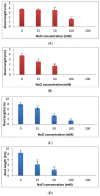Effect of Salinity Stress on Growth and Metabolomic Profiling of Cucumis sativus and Solanum lycopersicum
- PMID: 33238519
- PMCID: PMC7700630
- DOI: 10.3390/plants9111626
Effect of Salinity Stress on Growth and Metabolomic Profiling of Cucumis sativus and Solanum lycopersicum
Abstract
Seeds germination and seedlings growth of Cucumis sativus and Solanum lycopersicum were monitored in in vitro and in vivo experiments after application of different concentrations of NaCl (25, 50, 100 and 200 mM). Photosynthetic pigments content and the biochemical responses of C. sativus and S. lycopersicum were assessed. Salinity stress slightly delayed the seeds germination rate and significantly reduced the percentage of germination as well as shoot length under the highest salt concentration (200 mM) in cucumber. Furthermore, root length was decreased significantly in all treatments. Whereas, in tomato, a prominent delay in seeds germination rate, the germination percentage and seedlings growth (shoot and root lengths) were significantly influenced under all concentrations of NaCl. Fresh and dry weights were reduced prominently in tomato compared to cucumber. Photosynthetic pigments content was reduced but with pronounced decreasing in tomato compared to cucumber. Secondary metabolites profiling in both plants under stress was varied from tomato to cucumber. The content of saponins, proline and total antioxidant capacity was reduced more prominently in tomato as compared to cucumber. On the other hand, the content of phenolics and flavonoids was increased in both plants with pronounced increase in tomato particularly under the highest level of salinity stress. The metabolomic profiling in stressful plants was significantly influenced by salinity stress and some bioactive secondary metabolites was enhanced in both cucumber and tomato plants. The enhancement of secondary metabolites under salinity stress may explain the tolerance and sensitivity of cucumber and tomato under salinity stress. The metabolomic evaluation combined with multivariate data analysis revealed a similar mechanism of action of plants to mediate stress, with variant level of this response in both plant species. Based on these results, the effect of salinity stress on seeds germination, seedlings growth and metabolomic content of plants was discussed in terms of tolerance and sensitivity of plants to salinity stress.
Keywords: PCA; cucumber; metabolomic; photosynthetic pigments; root length; shoot length; tomato.
Conflict of interest statement
The authors declare no conflict of interest.
Figures












Similar articles
-
Tomato responses to salinity stress: From morphological traits to genetic changes.Front Plant Sci. 2023 Feb 10;14:1118383. doi: 10.3389/fpls.2023.1118383. eCollection 2023. Front Plant Sci. 2023. PMID: 36909434 Free PMC article. Review.
-
Mitigation of salinity stress in cucumber seedlings by exogenous hydrogen sulfide.J Plant Res. 2022 May;135(3):517-529. doi: 10.1007/s10265-022-01391-y. Epub 2022 Apr 21. J Plant Res. 2022. PMID: 35445911
-
Effect of soil aeration on root morphology and photosynthetic characteristics of potted tomato plants (Solanum lycopersicum) at different NaCl salinity levels.BMC Plant Biol. 2019 Jul 29;19(1):331. doi: 10.1186/s12870-019-1927-3. BMC Plant Biol. 2019. PMID: 31357955 Free PMC article.
-
Effects of 60 Hz Non- Uniform Electromagnetic Fields on Tomato (cv L-05) Seed Germination, Photosynthesis and Seedling Growth Under Salt Stress Conditions.Bioelectromagnetics. 2025 Feb;46(2):e22537. doi: 10.1002/bem.22537. Bioelectromagnetics. 2025. PMID: 39876622
-
Tomato salt tolerance mechanisms and their potential applications for fighting salinity: A review.Front Plant Sci. 2022 Sep 14;13:949541. doi: 10.3389/fpls.2022.949541. eCollection 2022. Front Plant Sci. 2022. PMID: 36186008 Free PMC article. Review.
Cited by
-
Evaluation of cucumber seed germination vigor under salt stress environment based on improved YOLOv8.Front Plant Sci. 2024 Sep 13;15:1447346. doi: 10.3389/fpls.2024.1447346. eCollection 2024. Front Plant Sci. 2024. PMID: 39354946 Free PMC article.
-
Tomato responses to salinity stress: From morphological traits to genetic changes.Front Plant Sci. 2023 Feb 10;14:1118383. doi: 10.3389/fpls.2023.1118383. eCollection 2023. Front Plant Sci. 2023. PMID: 36909434 Free PMC article. Review.
-
The Physiological and Biochemical Responses of European Chestnut (Castanea sativa L.) to Blight Fungus (Cryphonectria parasitica (Murill) Barr).Plants (Basel). 2021 Oct 8;10(10):2136. doi: 10.3390/plants10102136. Plants (Basel). 2021. PMID: 34685944 Free PMC article.
-
Metabolomic and Biochemical Analysis of Two Potato (Solanum tuberosum L.) Cultivars Exposed to In Vitro Osmotic and Salt Stresses.Plants (Basel). 2021 Jan 6;10(1):98. doi: 10.3390/plants10010098. Plants (Basel). 2021. PMID: 33418964 Free PMC article.
-
Metabolomic and transcriptomic changes in mungbean (Vigna radiata (L.) R. Wilczek) sprouts under salinity stress.Front Plant Sci. 2022 Oct 17;13:1030677. doi: 10.3389/fpls.2022.1030677. eCollection 2022. Front Plant Sci. 2022. PMID: 36325566 Free PMC article.
References
-
- Maas E.V., Hoffman G.J. Crop salt tolerance-current assessment. J. Irrig. Drain. Div. 1977;103:115–134.
-
- Ali Y., Aslam Z., Ashraf M.Y., Tahir G.R. Effect of salinity on chlorophyll concentration, leaf area, yield and yield components of rice genotypes grown under saline environment. Int. J. Environ. Sci. Technol. 2004;1:221–225. doi: 10.1007/BF03325836. - DOI
-
- Kamran M., Parveen A., Ahmar S., Malik Z., Hussain S., Chattha M.S., Saleem M.H., Adil M., Heidari P., Chen J.T. An overview of hazardous impacts of soil salinity in crops, tolerance mechanisms, and amelioration through selenium supplementation. Int. J. Mol. Sci. 2020;21:148. doi: 10.3390/ijms21010148. - DOI - PMC - PubMed
-
- Sonar B.A., Desai Nivas D., Gaikwad D.K., Chanven P.D. Assessment of salinity-induced antioxidative defense system in Colubrina asiatica Brong. J. Stress Physiol. Biochem. 2011;7:193–200.
-
- Movafegh S., Jadid R.R., Kiabi S. Effect of salinity stress on chlorophyll content, proline, water soluble carbohydrate, germination, growth and dry weight of three seedling barley (Hordeum vulgare L.) cultivars. J. Stress Physiol. Biochem. 2012;8:157–168.
LinkOut - more resources
Full Text Sources

